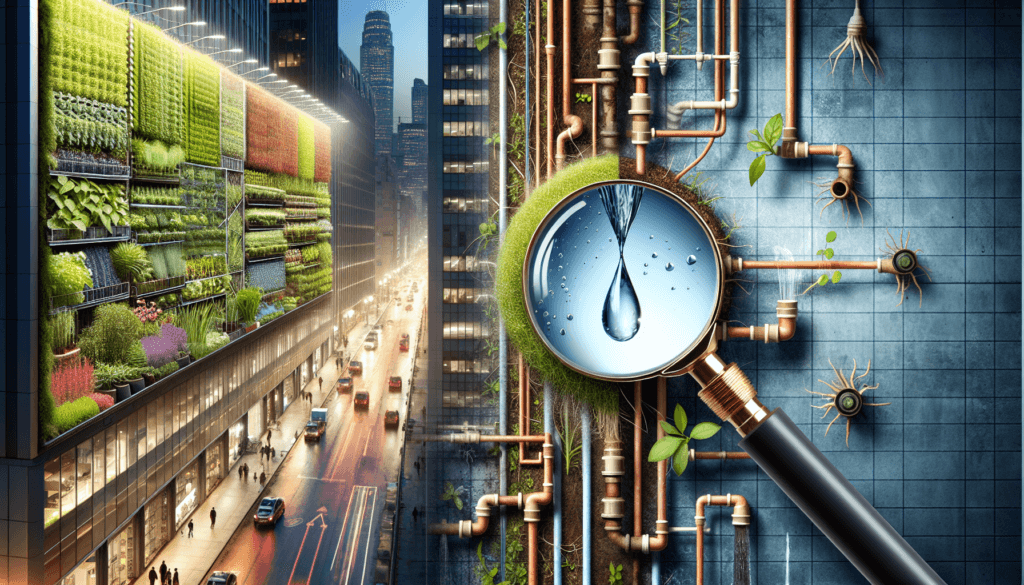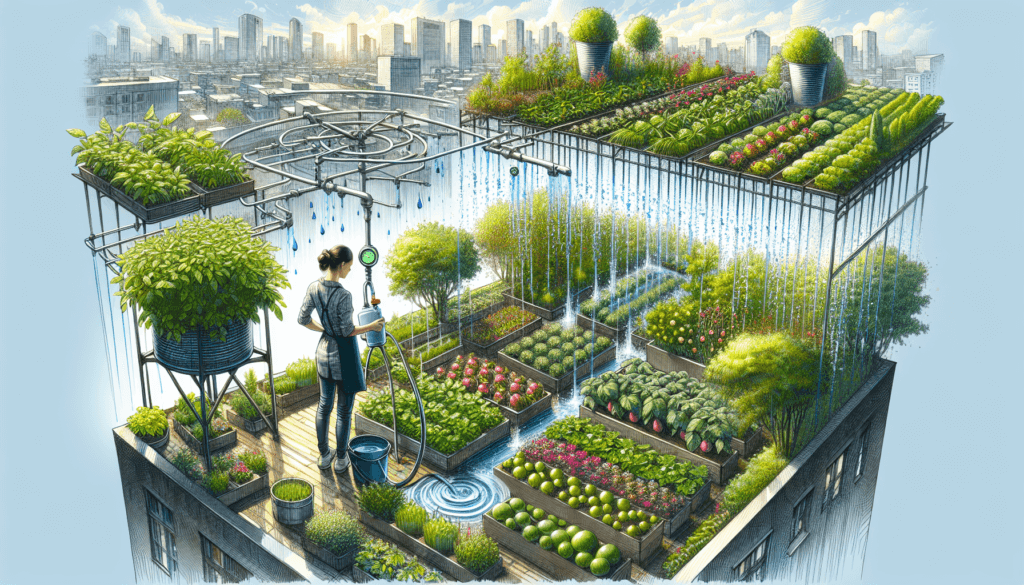In urban settings where space is limited, water scarcity can present a challenge for gardeners seeking to cultivate a thriving oasis amidst concrete jungles. However, there are ingenious ways to make the most of limited water resources in urban gardens, ensuring that plants flourish and water is conserved. By implementing water-saving techniques such as drip irrigation, mulching, and harvesting rainwater, you can not only maximize your limited water supply but also create a sustainable and vibrant urban garden that brings joy and beauty to your surroundings.

Choosing Drought-Tolerant Plants
When it comes to creating a water-efficient garden, one of the key factors to consider is choosing drought-tolerant plants. These plants are adapted to survive and thrive in arid conditions, making them an excellent choice for conserving water in your urban garden.
To start, it’s important to research and select suitable plants for your specific climate and soil conditions. Look for plants that are known to thrive in dry environments, such as succulents, cacti, and Mediterranean herbs. These plants are typically adapted to store water in their leaves or have deep root systems that can access water from lower soil levels.
Another factor to consider is the water needs of different plants. Some plants require more water than others, so it’s essential to choose a variety of plants with varying water needs. This will allow you to create an aesthetically pleasing garden while still conserving water. Take into account factors such as the size of the plant, its growth rate, and its native environment.
Additionally, considering native and adapted species is crucial. Native plants are well-suited to the local climate and are often more drought-tolerant. They have evolved to thrive in the area’s natural conditions and can make a significant difference in water efficiency. Adapted species are non-native plants that have been successfully acclimated to a particular region, making them another great choice for water-wise gardening.
Implementing Efficient Irrigation Systems
Installing efficient irrigation systems is another essential step in maximizing limited water resources in urban gardens. By using the right irrigation methods, you can ensure that water is delivered directly to the plants’ roots, minimizing waste and maximizing efficiency.
One effective method is to install drip irrigation systems. These systems deliver water slowly and directly to the plants’ root zones, reducing water loss due to evaporation or runoff. Drip irrigation systems can be easily installed in both garden beds and containers, and they allow for precise control over water delivery to different areas of your garden.
Using timers and sensors is another useful technique. Timers can be set to automatically water your garden at specific times of the day, ensuring consistent and efficient watering. Sensors, such as moisture sensors, can detect when the soil is dry and trigger the irrigation system, preventing overwatering.
To further minimize water loss, consider using mulch. Apply a layer of organic mulch around your plants to help retain soil moisture, reducing the frequency of watering needed. Mulch also acts as a natural insulator, regulating soil temperature and minimizing evaporation.

Collecting and Storing Rainwater
Rainwater is a valuable resource that can be used to supplement your garden’s water needs. By collecting and storing rainwater, you can reduce your reliance on municipal water sources and make efficient use of the natural precipitation.
Installing rain barrels or cisterns is a practical step in capturing rainwater. These containers can collect and store rainwater runoff from rooftops. When properly placed and connected to your irrigation system, you can use the collected rainwater to water your plants, effectively reducing your reliance on potable water.
When choosing the right storage capacity for your rain barrels or cisterns, consider the size of your garden and the average rainfall in your area. Aim for a size that can accommodate enough water to sustain your plants between rain events without overflowing.
Once you have collected rainwater, it’s crucial to use it efficiently. Consider using a watering can or a drip irrigation system to apply the collected rainwater directly to the plants’ roots. This ensures maximum water absorption and minimizes waste.
Implementing Water-Smart Design
Water-smart design techniques can significantly contribute to a water-efficient garden. By implementing these strategies, you can create a garden that conserves water and is aesthetically pleasing.
Grouping plants with similar water needs is one effective technique. By planting together plants that have similar water requirements, you can avoid overwatering some while underwatering others. This approach allows you to provide the right amount of water to each plant, increasing efficiency and ensuring their health.
Creating shade and wind barriers can also contribute to water efficiency. By strategically placing taller plants or structures to provide shade, you can reduce evaporation and limit water loss. Creating wind barriers, such as hedges or trellises, can protect plants from drying winds, minimizing water stress.
Designing raised beds or using containers is another water-smart design idea. These methods allow for better control over soil moisture levels. Raised beds often retain moisture better than traditional garden beds, while containers provide a controlled environment for water management.

Managing Soil Health and Moisture
Healthy soil plays a crucial role in water efficiency. By managing soil health and moisture, you can create an environment that retains water and supports plant growth, reducing the need for excessive watering.
Amending soil with organic matter is an excellent way to improve its water-holding capacity. Organic matter, such as compost or well-rotted manure, helps soil retain moisture and provides nutrients to your plants. Incorporate these materials into your soil when planting or as a top dressing, making sure to mix them thoroughly.
Using compost and mulch is another effective technique. Apply a layer of compost to nourish the soil and provide a slow-release source of nutrients. Additionally, add a layer of mulch around your plants to retain moisture, suppress weed growth, and protect the soil from extreme temperatures.
Testing soil moisture regularly is crucial to ensure that your plants are receiving the right amount of water. Use a moisture meter or simply check the soil with your fingers. Adjust your watering schedule accordingly to prevent under or overwatering, promoting optimal plant health and water efficiency.
Practicing Water-Wise Gardening Techniques
Water-wise gardening techniques can help you maximize the limited water resources in your urban garden. By following these practices, you can ensure that water is used efficiently and your plants thrive in a water-conscious environment.
Watering deeply and infrequently is a key technique. Instead of giving your plants frequent shallow waterings, which can encourage shallow root growth, water your plants deeply. This encourages the development of deeper root systems, allowing plants to access water from lower soil levels and reducing the need for frequent watering.
Implementing proper timing for watering is also essential. Water your plants early in the morning or late in the evening when evaporation rates are lower. This ensures that more water reaches the roots instead of being lost to evaporation, maximizing water efficiency.
Avoiding water runoff is another important practice. When watering your plants, apply water slowly and evenly to allow the soil to absorb it properly. If you notice water pooling or running off, take a break and give the soil time to absorb the water before resuming watering.

Using Water-Saving Techniques
In addition to the water-wise gardening techniques mentioned earlier, there are several other water-saving techniques you can implement in your urban garden.
Using graywater and recycled water is one such technique. Graywater is wastewater generated from domestic activities such as laundry or dishwashing. Rather than letting this water go to waste, it can be collected and used to water non-edible plants in your garden. Additionally, recycled water, such as water collected from dehumidifiers or air conditioning units, can also be used for irrigation purposes.
Implementing micro-irrigation systems is another effective water-saving technique. Micro-irrigation delivers water directly to the plants’ root zones through small emitters or drippers. This method minimizes water loss due to evaporation or runoff and ensures precise water delivery to each plant.
Avoiding overwatering is crucial in conserving water resources. It’s important to monitor soil moisture levels regularly and adjust your watering schedule or duration accordingly. If the soil is already moist, it’s better to skip watering rather than risk saturating the soil and potentially harming your plants.
Optimizing Watering Practices
To maximize water efficiency, it’s important to optimize your watering practices. By following these recommendations, you can ensure that water is used most effectively in your urban garden.
Watering early in the morning or late in the evening is ideal. During these times, temperatures are cooler, and evaporation rates are lower, allowing plants to make the most of the water they receive. Watering during the day, especially in direct sunlight, can result in significant water loss due to evaporation.
Watering at the base of plants is another effective technique. Direct the water flow towards the soil at the base of the plant rather than spraying water on the foliage. This reduces water loss due to evaporation and ensures that the water directly reaches the roots where it’s needed the most.
Using a watering can or wand instead of a hose or sprinkler system can also contribute to water efficiency. This allows for better control over the amount of water being applied and precise targeting of the plants’ root zones, minimizing waste.

Mulching to Conserve Moisture
Mulching is an excellent technique to conserve moisture in your urban garden. By applying a layer of mulch around your plants, you can reduce evaporation, suppress weed growth, and improve overall water efficiency.
Choosing suitable mulching materials is important. Organic mulches like wood chips, straw, or shredded leaves are often the best choice. They not only help retain moisture but also break down over time, adding organic matter to the soil and improving its structure.
Applying mulch around plants is a straightforward process. Spread a layer of mulch around the base of your plants, ensuring that it is evenly distributed and does not touch the stems, which can cause rotting or disease.
Maintaining the proper thickness of mulch is crucial. Aim for a thickness of 2-4 inches, which provides adequate insulation and moisture retention without smothering the plants. Regularly check the thickness of the mulch and replenish as needed throughout the growing season.
Monitoring and Adjusting Water Usage
Regularly monitoring and adjusting your water usage is essential to ensure optimal water efficiency in your urban garden. By paying attention to soil moisture levels and plant health indicators, you can make informed decisions about your watering practices.
Regularly check soil moisture levels using a moisture meter or by simply observing the soil’s appearance and texture. This will allow you to determine if your plants are receiving enough water or if adjustments need to be made to your watering schedule.
Adjust irrigation timing and duration based on your observations. If the soil is consistently dry or your plants are wilting, consider increasing the frequency or duration of your watering sessions. On the other hand, if the soil remains damp or your plants show signs of overwatering, scale back on your watering schedule.
Monitor plant health indicators such as leaf color and texture, as well as overall growth and vigor. Healthy plants with vibrant green leaves indicate that they are receiving adequate water. If you notice signs of stress, such as yellowing leaves or stunted growth, it may be a sign that you need to adjust your watering practices.
In conclusion, maximizing limited water resources in urban gardens is crucial for sustainable and water-efficient gardening. By following the tips and techniques outlined in this article, you can create a garden that conserves water while still providing a thriving environment for your plants. From choosing drought-tolerant plants to implementing efficient irrigation systems and practicing water-wise gardening techniques, every step you take towards water efficiency contributes to a greener and more sustainable future.


